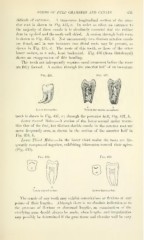Page 453 - My FlipBook
P. 453
F0B3fS OF PULP CHAMBERS AND CANALS. 451
difficult of fiitranee. A transverse longitudinal section of the ante-
rior root is shown in Fig. 435, c. In order to effect an entrance to
the majority of these canals it is absolutely essential that the rubber
dam be :)])plied and the tooth well dried. A section through both roots
is shown in Fig. 435, b. Not uncommonly two distinct anterior canals
are found, and in rare instances two distal roots may be present, as
shown in Fig. 435, d. The roots of this tooth, as those of the other
lower molars, as a rule, bend backward. Fig. 436 (from Ottolengui)
shows an exaggeration of this bending.
This tooth not infrequently requires canal treatment before the roots
are fully formed. A section through the anterior half of an immature
Fig. 436. Fig. 437.
Lower finst molar. Lower lirst molar, immature.
tooth is shown in Fig. 437, «; through the posterior half. Fig. 437, 6.
Loiver /Second Molar.—A section of the lower second molar resem-
bles that of the first, but distinct double canals in the anterior root are
more frequently seen, as shown in the section of the anterior half in
Fig. 438, 6.
Lower Third Molar.—In the lower third molar the roots are fre-
quently compressed together, exhibiting bifurcation toward their apices
(Fig. 439).
Fig. 438. Fig. 439.
a
Lower second molar. Lower third molar.
The canals of any tooth may exhibit constrictions or flexions at any
points of their lengths. Although there is no absolute indication as to
the presence of flexions or abnormal lengths, an examination of the
overlying gum should always be made, when lengths and irregularities
may possibly be determined if the gum tissue and alveolar wall be very


